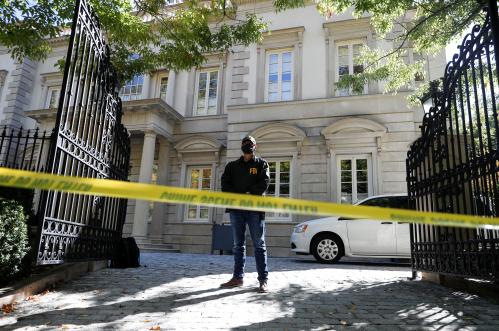A central theme of the Brookings Metropolitan Policy Program’s Blueprint for American Prosperity is that sustainable growth strengthens existing cities and communities, conserves fiscal and natural resources, and advances U.S. efforts to address climate change and achieve energy independence. Sustainable places are those in which people have a variety of options in housing type, neighborhood type, and transportation mode. Density is a key element of these places, as is a rich array of amenities that attract workers and families. In fact, sustainable, quality places are a key driver of metropolitan, and thus national, prosperity.
While many federal agencies have a role in creating quality places (including EPA, the Department of Transportation, and the Department of Energy, and the Department of Education) the Department of Housing and Urban Development shows a particularly remarkable commitment to this issue in its FY2010 budget proposal. HUD is especially creative in integrating the elements of quality places, such as housing and schools, housing and transportation, and housing and energy efficiency. The detailed HUD budget and budget summary also reflect an understanding that housing needs to be seen in the context of communities and regions, and that housing policy needs to be developed in concert with transportation and energy policy. Sustainable places cannot be built without these connections.
HUD’s investment in sustainability shows up in several places. The largest of these is the Community Development Block Grant (CDBG) program, with a 2010 request of $4.45 billion, which would represent a $550 million (14 percent) increase over funding in FY 2009. Within the CDBG program, HUD envisions four programs to support sustainable places from the neighborhood to the metropolitan scale: 1) the Choice Neighborhoods Initiative; 2) the Sustainable Communities Initiative; 3) the University Community Fund; and 4) the Rural Innovation Fund.
- The Choice Neighborhoods Initiative, proposed at $250 million, would build upon HUD’s successful HOPE VI program. The program would fund competitive grants for the preservation, rehabilitation, and transformation of public and federally-assisted housing. Grantees could also fund community services, community development activities, and the acquisition and renovation of privately owned but distressed housing, and new construction of mixed-income housing. Local governments, non-profits, and private firms would be eligible for Choice Neighborhoods funding. HUD intends to target the funds to cities and neighborhoods that are also engaged in intensive school and early child development activities, linking neighborhood transformation and education reform.
- HUD envisions using $150 million of its incremental CDBG funds for a Sustainable Communities Initiative, which will “integrate transportation and housing planning decisions in a way that maximizes choices for residents and businesses, lowers transportation costs and drives more sustainable development patterns”. The Sustainable Communities Initiative closely tracks the Sustainability Challenge Grant program proposed in the Brookings Blueprint Report, “Metropolicy: Shaping a New Federal Partnership for a Metropolitan Nation.”
The Initiative has three components. The first is a $100 million regional planning effort jointly administered by HUD and the Department of Transportation. Metropolitan planning organizations and teams of CDBG recipients would tender joint applications to HUD and DOT, asking for support for integrated regional development plans based on fresh data and sophisticated planning tools. The program emphasizes planning across jurisdictional borders and across different federal program silos. This policy integration and emphasis on on-the-ground coordination is a significant departure from standard operating practice at HUD and DOT, and across federal agencies in general.
Good regional plans, however, are not complete in and of themselves. Localities need to align their own zoning and land-use rules with larger visions, so the initiative’s second component is a community challenge grant. These grants, $40 million in total, could be used for local zoning code reform or state building code overhaul, or other efforts to facilitate mixed-use developments, encourage building rehabilitation, and better link the existing built environment to existing infrastructure.
The last element of the Sustainable Communities Initiative would support $10 million for research and evaluation, also jointly administered by HUD and DOT (26). Agencies cannot know if they are meeting their goals unless they have the right data and performance measures. HUD and DOT would, among other things, collaborate to make transparent households’ combined housing and transportation costs by location, and evaluate the performance of location-efficient mortgages.
- Another $25 million in CDBG funds would go towards a University Community Fund, to support a competitive grant program that enables universities to spark revitalization in their surrounding neighborhoods. And $25 million would go to a Rural Innovation Fund, to support innovative approaches to alleviating concentrated rural poverty and community distress.
HUD also proposes two entirely new budget lines for sustainability endeavors: $100 million for an energy innovation fund and $2.4 million for an Office of Sustainable Housing and Communities.
The energy innovation fund aims to “catalyze a residential energy retrofit and new construction market in the United States”. It will do this through a $50 million grant program, the Local Initiatives Fund, which will support local energy efficiency retrofit initiatives, such as green retrofit investment funds, private-sector investments, and on-bill utility financing. On-bill financing was a specific recommendation of the Blueprint Policy paper, Shrinking the Carbon Footprint of Metropolitan America. HUD’s goal is to create model retrofit programs in ten or more communities and then adjust them for other markets and build upon substantial retrofit activities funded in the Recovery Act.
Fund dollars will also go towards overhauling the Federal Housing Administration’s Energy Efficient Mortgages program so that more homeowners take advantage of the program—which currently supports only about 1,000 mortgages each year. HUD also intends to spend $25 million to lower the cost of mortgage insurance premiums for multi-family properties through FHA, in hopes that the reduction will encourage owners of these large buildings to make their properties more energy efficient. These kinds of incentives for energy efficient housing incentives were also recommended in the Blueprint’s carbon footprint brief.
The Office of Sustainable Housing and Communities, although tiny in terms of funds, will have an expansive mission: “to advance housing and communities that promote affordable, livable, and sustainable living environments.” The Office will be the glue that holds HUD’s partnerships with DOT, Department of Energy, and the Environmental Protection Agency together, and it will co-manage the Sustainable Communities Initiative (funded through CDBG) and the Energy Innovation Fund.
One other new HUD program is of note, the Transformation Initiative. This initiative would take one percent of HUD’s budget and dedicate it to rigorous research and evaluation programs, major research demonstrations, technical assistance and capacity building, and better information technology. Some of these dollars would help states and CDBG grantees design, implement, and assess community revitalization strategies. Too often, federal agencies operate in a “fact-free zone,” and no one measures whether the tremendous efforts necessary to implement programs yield commensurate results. HUD’s Transformation Initiative will direct local sustainability efforts towards the most effective programs
Additionally, the Environmental Protection Agency proposed budget includes several sustainability initiatives. The agency proposes to more than double FY 2009 funding for the Clean Water and Drinking Water State Revolving Funds, allocating $3.9 billion to support water infrastructure projects for states, tribes and U.S. territories. EPA will encourage revolving funds to support green infrastructure projects. EPA’s budget proposal also includes $943 million for land cleanup so that polluted tracts can be restored to productive uses, including use as sites of renewable energy facilities. Finally, EPA aims to spend $17 million to develop a greenhouse gas emissions inventory, and $5 million to start developing the methodology for a greenhouse gas cap and trade program.
Sustainability is not a luxury, to be funded in flush times and abandoned when the economy weakens. Transportation costs eat up an increasing share of family budgets—sustainability investments give people more transportation options. Fluctuating energy costs leave homeowners vulnerable to sudden spikes in their utility bills—efficiency investments mitigate those swings, in addition to providing good-paying jobs for entry-level workers and lowering greenhouse gas emissions. The FY 2010 budget choices are not only good for the long term, but also appropriate for the current economically challenging times.



Commentary
Op-edBudget 2010: Sustainability and Quality Places
May 14, 2009